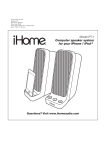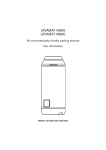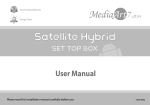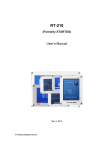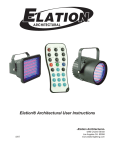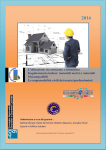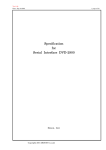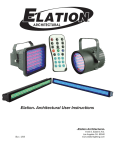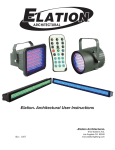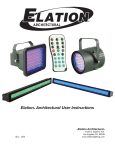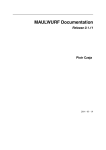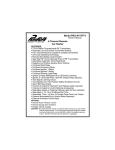Download CoGNITIVE HuMAN FACToRs
Transcript
Cognitive Human Factors Usability Test Report Product Tested: Voyager 2, Multi language Handheld Translator Test Conducted by: Stephanie Krieger, Shilpa Rao, Erica Yamada Test Conducted on: Sunday, Oct 7, 2007, 12:00hr-15:00hr Report Prepared on: October 11, 2007 Report Prepared by: Stephanie Krieger, Shilpa Rao, Erica Yamada Product Company: Lingo Executive Summary: The intent of this usability test was to get an insight on the user experience with the translator when they have not reviewed the user manual. Interaction with the physical user interface of the buttons, along with the screen interface was a major aspect of our test and allows us to review how different users may approach this product on their own. A high level overview of the test includes: The Method The Intent A Cognitive Walk through, two users tested with 6 tasks To examine the actual user experience of the translator’s screen interface 1.1 About Our Product: The Lingo Voyager 2 Multi-Language Talking Translator is a hand held device that translates English, German, French, Spanish, Italian, phonetic Greek, phonetic Russian, phonetic Chinese, phonetic Japanese, phonetic Korean, phonetic Arabic and phonetic Hebrew. It translates over 240,000 words and contains 27,000 useful and popular phrases and features a talking feature that pronounces translations out loud. Additional aspects of the product include: voice & memo recorders, 6 travel games, currency and measurement converters, calculator, alarm clock and international time zones. The screen is an 8-line back lit LCD display. The item comes with a black leather case that doubles as a credit card holder, several keyboard plates that fit over the keypad, (in order to type in characters for different alphabets) headphones, batteries and re-set stylus. Retail price: MS RP $199 Weight: 8.0 oz Size: 6.0” x 3.25” x 0.50” in a) Aspect being tested: User screen and keypad interface b) Need for product: People who are in need of a 12 language translator c) Product use: Environment may be set for use on the road, while travelling. Portability is key and product may be used anywhere d) Typical user: A physically healthy (not blind) traveler in a foreign environment 1.2 Participants Our usability test was conducted on two participants. Participants were first given a questionaire checking if they were typical users for the Lingo Translator. The users were asked to volunteer their participation in the study. There was no compensation for their time. User Gender Age Education Occupation/ Role Frequency of Travel Reason for Travel Computer Experience P1 Jesse Laufer male 23 BS Student/EMT A couple times a year Visit friends, family, pleasure Comfortable with hand held technology P2 Anand Rao male 32 MS Consultant Weekly Mostly for business, some pleasure Comfortable with hand held technology 1.3 Context of Product Use in the Test Most users of the Lingo Translator will be using the device under stress while trying to communicate in a foreign country. Our usability test was conducted in an English speaking country, with English speaking users, so they were not under this same stress. Additionally our users were not under the typical stress a translator user would be under as they were not holding up someone’s time and attention as they waited to be spoken to or understood. 1.3.1 Test Facility Usability test was conducted in a local cafe. Being a public space there was some noise in the background, typical to the sound distraction a user might experience while traveling. The test was conducted sitting at a private table with just the user and testers. 1.3.2 Experimental Design Like most usability studies, the present study was not experimental in natrue for three reasons. 1.Experiments require some form of manipulation by the experimenter (test administrator) which is used to compare two or more conditions. The current study did not compare two conditions since it did not compare two versions of the Lingo Translator. 2. Experiments require random selection. Random selection was not possible with this study due to the lack of available participants and time constraints. 3. Experimenter control: The experimenter was neither able to nor interested in controlling to extraneous variables such as room lights, temperature, furniture arrangement, and sound. The tester preferred not to place users in a controlled environment as users would face similar conditions using this product. 1.3.3 Tasks The following tasks were selected as they are typical tasks a traveler might do while abroad. Additionally the three tasks that include translation are essential for what the product is marketed to do. Without the ability to complete translating words and phrases to and from a foreign language the translator would no longer serve its function as a translator. Task 1: Turning On It is critical that the user be able to turn on the device in order to use it. The purpose of this test was to see how intuitive the location of the on button was and how long it took for the average user to turn the device on. The location of the On button is not as obvious as a cell phone, thus prompting us to make that a critical factorThe task was considered complete when the user had turned on the device and was prepared to move to the next task. Task 2: Translating Words and Phrases It is a primary function of the Lingo Translator to be able to translate words and phrases to and from foreign languages. Three subtasks were chosen that cover the various translation functions of the translator: converting English word to foreign language, translating English phrase to a foreign language, and translating a word from a foreign language to English. The purpose of these tests were to see how quickly, and how easily the users were able to complete these tasks. The task was considered complete when the user had successfully executed the translation and verbally told the tester the translation of the word or phrase. Task 3: Converting Currency Currency conversion is a typical task that traveling users often do and is a travel feature of the translator. The purpose of this test was to see how intuitive the conversion set up was after the user had experienced how other features of the translator worked. We were also looking to see how useful the user felt this function was. The task was considered complete when the user told us how much 34 Yuan was equal to in U.S. dollars. Task 4: Playing Game The Lingo Translator has five different games featured in the device. This task was chosen to see if the users were able to find and begin to play these games without written instructions as the average user may not think about additional features such as games while reading through the instruction manual. The purpose of this test was to see if the user was able to understand the games without the aid of the written instruction manual. The task was considered complete after the user entered the game and began playing and said they were confident they understood and could continue playing the game. 1.4 Participant General Instructions Thank you for helping us conduct our usability test on the Lingo Translator. Through this test we hope you will be able to help us identify positive and negative features of the translator as well as discovering aspects that are easy or difficult to use. There are three of us here, I will be talking you through our test while the other two members of our team will be taking notes and taking pictures. This is to help us recall your experiences later. For this test we will be giving you the Lingo Translator to work through a few typical tasks we expect average users of the translator to use. Please feel free to share any thoughts you are having with us as you go through this process. For example, you might tell us “I am looking for the calculator function” or “I am deciding what I need to translate.” Having some idea of what you are thinking will help us understand your process as you move through the tasks. 1.4 Participant General Instructions (Cont’d) Please keep in mind that we are testing the interface of the translator and not you. There are no right or wrong ways to go through this, so there is no need to be nervous. You can take as much time as you are comfortable taking to complete each of the tasks. If you want to stop and move on before a task is completed please notify me. Testing on specific tasks were then executed. We have now completed our tests regarding the usability of the Lingo Translator. From your brief experience with the device is there anything that you would change? Are there features that you feel are missing, or additional features that you would want added? Would you purchase and use this device? Thanks you so much for participating in our usability study. We appreciate you taking the time to help us. We will be presenting our report to our class later this month. If you would like a copy of the report please contact us and we will provide you with one. 1.4.1 Participant Task Instructions Task 1: Turning On User is presented the translator in a closed case. User is then instructed to turn on the device. If user asks if they can remove the case they are told of course, but the user was not instructed to do it. Task 2: Translating Words and Phrases User is instructed to translate the word “banana” into German. Upon completing this translation, user is told that the translator has the ability to translate common phrases in addition to words. They are than asked to translate the phrase “Where is the bathroom?” into French. Upon completion of this task the user is told that the translator has the ability to input foreign languages with different alphabets. They are told that in order to do this there are separate keyplates that can be placed on the keypad to use various alphabets. The user is then given the two keyplates. The user is then presented with a Japanese word phonetically written out. The user is then instructed that in order to use this function they need to have some understanding of the Japanese alphabet. They are then presented with paper containing the phonetic Japanese alphabet written out. The user is told how the letters relate to each other and given a short explanation of how they can use the keypad to write the different letters. The user is then instructed to translate the word they were given to English. Task 3: Converting Currency The user is told that in addition to translation, this device has a function to convert various currencies. The user is then instructed to convert 34 Yuan to American Dollars. They are then told that this device does not contain current rates and is informed that the conversion rate is 7.8 Yuan to the Dollar. They are then left on their own. If they ask, they are told the abbreviation for Yuan is RMB. Task 4: Playing Game The user is then told that the translator also has five games on it. They are then asked to go and play a game. Upon entering and showing that they knew how to play one game the user is then asked to go back and try an additional game of their choice. 1.4.2 Usability Metrics Task 1: Turning on Locate button, Push button, Begin using translator Task 1 Level of DIFFICULTY Achieving Completed? Errors Assists User 1 Moderate difficulty Yes 4 (In locating button) Advised user to remove product form case 1.4.2 Usability Metrics (Cont’d) User 2 Easy Yes 0 User immediately asked for permission to remove product from case In order to easily locate the button the outside cover, which is sold with for protection, must be removed. One user quickly removed the jacket locating it easily, other user assumed product would work more like his cell phone and looked on the main keyboard and was hesitant to completely take of the jacket, asking if it was ok. This made the task more difficult. Task 2: Translating words and phrases 2.1: Getting to translating: Enter main menu, Decide if you want to look up a word or phrase Task 2.1 Level of DIFFICULTY Achieving Completed? Errors Assists User 1 Easy Yes 0 none User 2 Easy Yes 0 none 2.2: Translating words: Choose words from Main Menu Task 2.2 Level of DIFFICULTY Achieving Completed? Errors Assists User 1 Easy Yes 0 none User 2 Easy Yes 0 none 2.3: Translating words: Type in Word Task 2.3 Level of DIFFICULTY Achieving Completed? Errors Assists User 1 Easy Yes 0 none User 2 Easy Yes 0 none 2.4: Translating words: Scroll to Desired Word Task 2.4 Level of DIFFICULTY Achieving Completed? Errors Assists User 1 Easy Yes 0 none User 2 Easy Yes 0 none 2.5: Translating words: Select Enter Task 2.5 Level of DIFFICULTY Achieving Completed? Errors Assists User 1 Easy Yes 0 none User 2 Easy Yes 0 none 2.6: Translating words: Press button for appropriate language Task 2.6 Level of DIFFICULTY Achieving Completed? Errors Assists User 1 Difficult Yes 0 none User 2 Moderately Difficult Yes 0 none 1.4.2 Usability Metrics (Cont’d) 2.7: Translating words: Scroll translated options, Read translation Task 2.7 Level of DIFFICULTY Achieving Completed? Errors Assists User 1 Easy Yes 0 none User 2 Easy Yes 0 none 2.8: Translating words: Have machine pronounce translation Task 2.8 Level of DIFFICULTY Achieving Completed? Errors Assists User 1 Moderately Easy Yes 2 none User 2 Easy Yes 0 none Both of our users struggled a little bit with identifying the correct button in order to pick the language you wanted to translate to. Our first user struggled for a long time, as the system (having individual buttons on top for each language) though labeled did not fit his mental model. Jesse assumed that there would be a setting that you have to set up before going into the “word” option to (identify which language you were working in. It took a significant amount of time, trying a variety of things first, from going all the way back in the menu, to trying to scroll through the pages he was on, before he was able to locate the correct button. Our second user had a slightly quicker time finding it, as his mental model was closer. He assumed that being translation was the main feature of the product that he would not have to go deep into a menu to find the language keys. He first tried scrolling to a “more” area once in the word feature, but after that was not successful he immediately looked at the keyboard. He associated it with a cell phone. Entering his word was like putting in a phone number, and pressing the language key was like hitting call on his phone. He commented that it was not something he should have to set up, as it was the main feature of the product. 2.3.1: Translating phrases: Choose Phrases, from Main Menu Task 2.3.1 Level of DIFFICULTY Achieving Completed? Errors Assists User 1 Easy Yes 0 none User 2 Easy Yes 0 none 2.3.2: Translating phrases: Choose Category Task 2.3.2 Level of DIFFICULTY Achieving Completed? Errors Assists User 1 Difficult Yes 11 none User 2 Difficult Yes 6 none 2.3.3: Translating phrases: Scroll to Desired Topic Task 2.3.3 Level of DIFFICULTY Achieving Completed? Errors Assists User 1 Difficult Yes 0 none User 2 Difficult Yes 0 none Completed? Errors Assists 2.3.4: Translating phrases: Select Enter Task 2.3.4 Level of DIFFICULTY Achieving 1.4.2 Usability Metrics (Cont’d) User 1 Easy Yes 0 none User 2 Easy Yes 0 none 2.3.5: Translating phrases: Find appropriate phrase that matches task Task 2.3.5 Level of DIFFICULTY Achieving Completed? Errors Assists User 1 Difficult No 8 none User 2 Difficult Yes 4 In the end we allowed user to look for topic through words option Completed? Errors Assists 0 none 2.3.6: Translating phrases: Read Translation Task 2.3.6 Level of DIFFICULTY Achieving Previous task not completed User 1 User 2 Easy Yes While technically both users were able to understand the process to find the appropriate phrase, neither one successfully found their phrase through the “phrase” function. Each user was unable to locate the correct category and topic. There was also confusion about how the phrases were displayed once you entered your chosen topic for both users. They both thought that there was only one word in each topic as they didn’t see the arrow indicating you had the ability to scroll through more choices. Ultimately Anand decided to go through the word function, looking up “toilet” and then finding the phrase where is the toilet. At that point he commented that he would just not use the phrase function as it was too hard to sort through. 2.4.1: Translating word from Japanese to English: Choose Words from Menu Task 2.4.1 Level of DIFFICULTY Achieving Completed? Errors Assists User 1 Easy Yes 0 none User 2 Easy Yes 0 none 2.4.2:Translating word from Japanese to English: Push Button for appropriate language Task 2.4.2 Level of DIFFICULTY Achieving Completed? Errors Assists User 1 Easy Yes 0 none User 2 Easy Yes 0 none 2.4.3:Translating word from Japanese to English: Place Keypad faceplate where necessary Task 2.4.3 Level of DIFFICULTY Achieving Completed? Errors Assists User 1 Moderately Easy Yes 0 none User 2 Easy Yes 0 none 2.4.4:Translating word from Japanese to English: Start to type in word 1.4.2 Usability Metrics (Cont’d) Task 2.4.4 User 1 User 2 Level of DIFFICULTY Achieving Very Difficult Difficult Completed? Yes Yes Errors Assists 11 Reviewed Japanese alphabet with user and walked through the entering process 6 Reviewed Japanese alphabet with user and allowed user to sort through the rest Errors Assists 2.4.5:Translating word from Japanese to English: Scroll to Desired Word Task 2.4.5 Level of DIFFICULTY Achieving Completed? User 1 Some Difficulty Yes 4 User still had some lingering problems from previous task of typing in words User 2 Easy Yes 0 none 2.4.6:Translating word from Japanese to English: Select Enter, Scroll Translated options, Read translations Task 2.4.6 Level of DIFFICULTY Achieving Completed? Errors Assists User 1 Easy Yes 0 none User 2 Easy Yes 0 none For this task both of our users had to get over the difference in how the Japanese alphabet works versus the English. Anand commented that he would probably need some outside aid to complete this task, but felt that was understandable. While Jesse was inputing the word he experiences some difficulty as he was getting unexpected feedback from the translator. It was beeping at times, and he had a hard time figuring out how to go to the next letter. He assumed that the way this page would work would be similar to when he was typing in English, but it did work slightly different because of the difference in how the language works. They both were able to relatively quickly complete the task. The translator allows for inputting words in other languages but no scrolling through phrases unless you change the interface platform to Japanese based. Task 3: Converting Currency 3.1: Converting Currency: Enter main menu, Choose currency from Menu Task 3.1 Level of DIFFICULTY Achieving Completed? Errors Assists User 1 Easy Yes 0 none User 2 Easy Yes 0 none Errors Assists 3.2: Converting Currency: Arrow over to Appropriate Currency Task 3.2 Level of DIFFICULTY Achieving Completed? 1.4.2 Usability Metrics (Cont’d) User 1 Moderatly Easy Yes 1 Notified user that the abbreviation for Chinese Yuan is RMB User 2 Moderatly Easy Yes 1 Notified user that the abbreviation for Chinese Yuan is RMB 3.3: Converting Currency: Press F1 button for Edit, then enter appropriate rate, Push enter Task 3.3 Level of DIFFICULTY Achieving Completed? Errors Assists User 1 Easy Yes 0 none User 2 Moderately Difficult Yes 3 none 3.4: Converting Currency: Set Dominant Currency Task 3.4 Level of DIFFICULTY Achieving Completed? Errors Assists User 1 Easy Yes 0 none User 2 Moderately Difficult Yes 1 none 3.5: Converting Currency: Enter Currency amount Task 3.5 Level of DIFFICULTY Achieving Completed? Errors Assists User 1 Easy Yes 0 none User 2 Moderately Easy Yes 0 none 3.6: Converting Currency: Read Currency Conversion on Screen Task 3.6 Level of DIFFICULTY Achieving Completed? Errors Assists User 1 Easy Yes 0 none User 2 Easy Yes 0 none While both of our users went through this task relatively quickly, they did have some problems with the interface. Both agreed that having numbers across the top representing the currency instead of just showing the abbreviations for currency was not optimal as it created an extra step. Anand also struggled with having to press edit to enter the rates, but not needing to push edit to put in the amount you want to convert. He read the three lines as being equal, and tried to deal with them equally. Both of our users recognized that this was basically a calculator feature, and in most cases it would be easier to do the calculations in your head, even if you had to round a little to get the fast answer. Task 4: Playing games 4.1: Playing Games: Enter Main menu, Select Games in Menu Task 4.1 Level of DIFFICULTY Achieving Completed? Errors Assists User 1 Easy Yes 0 none User 2 Easy Yes 0 none 1.4.2 Usability Metrics (Cont’d) 4.2: Playing Games: Choose which game to play Task 4.2 Level of DIFFICULTY Achieving Completed? Errors Assists User 1 Moderatly Easy Yes 0 none User 2 Easy Yes 0 none 4.3: Playing Games: Scroll to Game and Press enter Task 4.3 Level of DIFFICULTY Achieving Completed? Errors Assists User 1 Easy Yes 0 none User 2 Easy Yes 0 none 4.4: Playing Games: Play Game Task 4.4 Level of DIFFICULTY Achieving Completed? Errors Assists User 1 Easy Yes 0 none User 2 Easy Yes 0 none Both of our users easily found the games and played them. They picked games from the list that they recognized and had no trouble figuring out how tomaneuver through them. 2.0 Results Being that we tested only two users there was insufficient data to see any statistical trends for our tasks. We had a completion rate of 100%, but there were varying levels of difficulty to complete tasks and our results aimed to measure those difficulties and show the beginnings of where certain users may or may not have issues with the product. 2.1 Data Analysis As this was a qualitative observation, there is no specific data to analyze to create statistical results. 3.0 Appendix Travel Questionaire: (Please circle your option) Basic: 1. Do you like to travel? Yes No 2. How often do you travel? Never 3. Do you usually travel: Domestically Weekly Monthly Yearly Internationally 4. Do you often travel with: Independently leisure business With tour groups, 5. If you don’t know the language of the country you are visiting, which of following do you do in order to prepare: Buy a travel dictionary Buy a electronic translator contact a local friend Any other: 6. Is luggage size/weight a factor in what you pack on your trips? Yes No 7. How confident/comfortable do you feel using hand held electronic devices? Very comfortable Ok Not at all comfortable 8.Do you own a cell phone? Yes No 9. If yes, what options in your cell do you use in addition to the call feature? Text message Games calculator Alarm Clock Any other: (Please feel free to circle more than one option) Translater Specific: 1. When in a foreign country, how do you deal with the language barrier? Travel dictionaries sign language electronic translators Any other: 2. What do you look for in a translation aid: speed large word base popular phrases Anyother: 3. How long does it take for you to communicate with a foreigner: Less than one minute 3 to 5 minutes More than 5 minutes 4. If you have any down-time when traveling, what do you do to pass time? Play games listen to music Read books 5. When on the road, are there any other tools that you wish you had on hand: games calculator Maps/GPS Music player Anyother: 6. When using hand held electronic devices what do you do when you get stuck or need help? Figure it out Ask for help Give up Anyother: Test Script Thank you for helping us conduct our usability test on the Lingo Translator. Through this test we hope you will be able to help us identify positive and negative features of the translator as well as discovering aspects that are easy or difficult to use. There are three of us here, I will be talking you through our test while the other two members of our team will be taking notes and taking pictures. This is to help us recall your experiences later. For this test we will be giving you the Lingo Translator to work through a few typical tasks we expect average users of the translator to use. Please feel free to share any thoughts you are having with us as you go through this process. For example, you might tell us “I am looking for the calculator function” or “I am deciding what I need to translate.” Having some idea of what you are thinking will help us understand your process as you move through the tasks. Please keep in mind that we are testing the interface of the translator and not you. There are no right or wrong ways to go through this, so there is no need to be nervous. You can take as much time as you are comfortable taking to complete each of the tasks. If you want to stop and move on before a task is completed just tell me. Testing on specific tasks were then executed. We have now completed our tests regarding the usability of the Lingo Translator. From your brief experience with the device is there anything that you would change? Are there features that you feel are missing, or additional features that you would want added? Would you purchase and use this device? Thanks you so much for participating in our usability study. We appreciate you taking the time to help us. We will be presenting our report to our class later this month. If you would like a copy of the report please contact us and we will provide you with one. User 1: Jesse Laufer Trying to find the “on” button. Figuring out words and phrases Having a hard time finding ”where is the bathroom” Playing with world time setting Explaining his user experience Converting currency with ease Jesse, after successfully plaing the game “24” User 2: Anand Rao Trying to find the “on” button. Trying to understand the project Converting currency but not with ease Trying to find “where is the bathroom?”. Figuring out words and phrases Explaining what he found annoying about the screen interface figuring out how to convert the word ‘apple’ from japanese to english















